Did you know the average American home’s electrical panel is over 30 years old? Our dependence on electricity is increasing. Having an efficient, updated panel is vital. Replacing one can greatly improve your home’s safety and efficiency. Let’s dive into the costs of this important upgrade.
When your home’s electrical panel is too old or can’t keep up with today’s electricity needs, it’s time to replace it. The cost varies. It depends on the new panel’s size, your current electrical system’s condition, and local labor prices.
Key Takeaways
- The average cost to replace an electrical panel in the United States ranges from $1,500 to $3,000, with the national average around $2,000.
- The size and capacity of the new electrical panel, as well as the complexity of the installation process, are the primary factors that influence the overall cost.
- Obtaining the necessary permits and hiring a licensed and experienced electrician are crucial steps in the electrical panel replacement process.
- Replacing an outdated or faulty electrical panel can improve the safety, efficiency, and overall value of your home.
- Regular inspections and preventive maintenance are critical for ensuring the long-term reliability and safety of your new electrical panel.
Understanding the Need for Electrical Panel Replacement
Our homes are using more electricity as we add more devices and systems. This means sometimes we need to replace our old or broken electrical panels. The electrical panel replacement process becomes important especially when our current panel can’t keep up with all the new gadgets and appliances we use.
Signs of an Outdated or Faulty Electrical Panel
If you notice your circuit breaker often trips, or your lights flicker, your panel might need replacing. Another sign is having no room left for more circuit breakers. Old panels might not have important safety features like AFCIs and GFCIs, which prevent fires and shocks. These signs show it’s time to think about a new electrical panel.
Safety Concerns with Aging Electrical Panels
Old electrical panels can be dangerous because they might not follow the newest safety rules. This could lead to electrical fires or shocks. That’s why changing to a newer, safe electrical panel is crucial. It keeps your home’s electrical system working well and safely.
Factors Influencing the Cost to Replace Electrical Panel
Several key factors affect the cost of replacing an electrical panel. These include the size, capacity, and the installation’s complexity.
Size and Capacity of the New Electrical Panel
Choosing a new electrical panel’s size and capacity can greatly impact your cost. Bigger panels with higher amp ratings cost more. They need extra materials, and labor, and might have a complicated installation process.
Think about your home’s current and future electrical needs. This will help you choose the right panel size and capacity. It ensures the panel you pick can carry the necessary electrical load.
Complexity of the Installation Process
The installation’s complexity also affects the project’s cost. Things like the old system’s age or the accessibility of the panel spot matter. So does the necessity for updates or repairs.
If your electrical system is old or not enough, you might need more work. This includes upgrading the main service. Such tasks can make the project much more expensive.
Preparing for the Electrical Panel Replacement
Getting ready for an electrical panel replacement starts with getting the right permits for electrical panel replacement. Any work on your main electrical system needs a permit in most places. If you don’t get the permits first, you risk fines and having to do everything over.
To get these permits, you’ll need to fill out an application. This application goes to your city or county’s building or electrical department. You also have to pay a fee. Getting approval takes time, usually a few days to a couple of weeks. So, it’s smart to apply early and plan your project timeline with this in mind.
After you’ve got your permits, you’re good to start the replacement. With everything in order, you can work knowing you’re following the rules. This careful preparation ensures your project goes well. It makes your home’s electrical system safer and more efficient.
Hiring a Licensed and Experienced Electrician
For electrical panel work, always choose a licensed electrician. Their knowledge and experience are essential.
If you try this job without the expertise, it’s risky and often illegal. For your home’s safety, trust a qualified electrician for all electric panel jobs.
Importance of Working with a Professional
A licensed electrician offers vital skills and knowledge. They can check your current panel, choose the right size for a new one, and follow safety laws. Plus, they’ll spot any hidden electrical problems and suggest how to fix them.
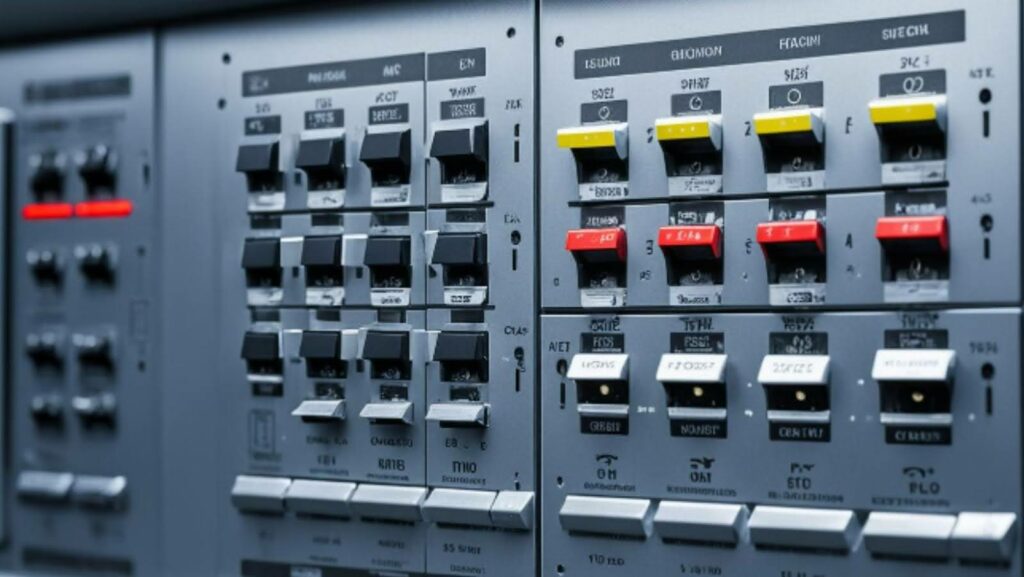
Checking Credentials and References
When picking an electrician to replace your panel, be thorough. Choose someone with a track record in home electrical work. Always ask for references and confirm their credentials and insurance. This ensures a reliable pro will do the job.
Costs Associated with Electrical Panel Replacement
The cost of replacing an electrical panel can change a lot. It depends on things like the new panel’s size and the setup’s complexity. The place where your home is located also plays a role.
Talking about costs upfront can help make a good budget. Homeowners should know about average costs and any extra expenses. This will let them plan well for this big home upgrade.
Average Costs Based on Panel Size and Location
New panel sizes affect the total cost the most. A smaller 100-amp panel might cost $1,500 to $2,500. A larger 200-amp one could be $2,000 to $3,500.
Where the home is matters too. In cities, labor and materials are usually costlier than in the country. Suburban areas also have different price points.
Panel Size Average Cost (Urban) Average Cost (Suburban) Average Cost (Rural)
100-amp $1,800 – $2,800 $1,500 – $2,300 $1,400 – $2,100
200-amp $2,500 – $3,800 $2,100 – $3,200 $1,900 – $2,900
Additional Costs for Upgrades or Repairs
There could be extra costs beyond the new panel price. This might include installing new breakers, replacing old wires, or meeting current building codes. These upgrades can add $500 to $2,000 more to your bill.
Electrical panel replacement is a big but necessary investment. It’s key for a safe and efficient home. Knowing all the influencing factors helps in planning your budget wisely.
Cost to Replace Electrical Panel
Cost to replace electrical panel depends on many factors. This includes the size and complexity of the new panel. The condition of the current electrical system also plays a part. So does the labor cost in the local area. Knowing these helps estimate the project’s total cost better.
Factors Affecting the Overall Cost
The new panel’s size and capacity affect its cost. Larger panels, needed for today’s homes with more electrical needs, are pricier. Also, if the installation requires upgrading the main electrical service or significant wiring changes, the cost goes up.
Where your home is also influences the project’s cost. This is because electrician labor rates can differ a lot depending on the area’s cost of living. This affects how much you pay for the replacement.
Potential Cost Savings and Financing Options
There are ways to reduce the electrical panel replacement’s cost. For instance, some utility companies have rebates for energy-efficient panels. This is a great way to save money. Also, looking into financing like home equity loans or personal loans can make payments easier on your budget.
Understanding what affects replacement costs and finding ways to save can make this home improvement more doable. It ensures your home has a safe and current electrical system.
Steps Involved in the Replacement Process
Replacing an electrical panel involves several key steps. This process requires careful planning and execution throughout.
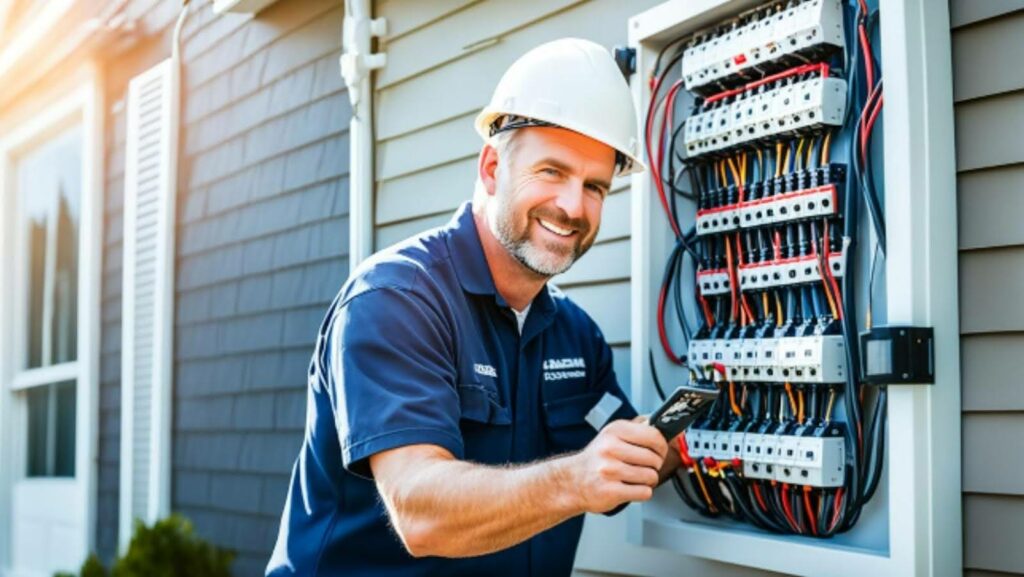
These steps include disconnecting and removing the old panel. Then, the new electrical panel gets installed. Finally, thorough testing and inspection are done to ensure everything works well.
Disconnecting and Removing the Old Panel
The first step is to safely disconnect and remove the old panel. This includes turning off the power and marking each wire. After this, the electrician takes out the old panel. They check the wires and may fix or update them as needed.
Installing the New Electrical Panel
After removing the old panel, the new one is put in place. The electrician mounts it securely and connects the main power. Each circuit breaker is then carefully wired. The electrician makes sure the new panel is grounded and that all connections are good.
Testing and Inspection
When the new panel is installed, a full check-up is done. The electrician looks at everything to make sure it’s working right. They test the breakers and check the voltage and amperage. Safety is a top concern. If all is well, the power is turned back on. This confirms that the work was successful.
Choosing the Right Electrical Panel for Your Home
Choosing the best electrical panel for your home is vital. It must meet all current and future energy needs. The size and capacity of the panel greatly affect the project’s cost and its ability to cover your energy demands.
Considering Your Energy Needs
Think about your home’s energy use now and in the future. Look at how much power your appliances, lights, and potential upgrades need. This evaluation is key in picking the right panel size and power capacity.
Future-Proofing with Upgradeable Panels
It’s smart to select a panel that can grow with your energy needs. As technology changes and your home uses more power, you’ll need flexibility.
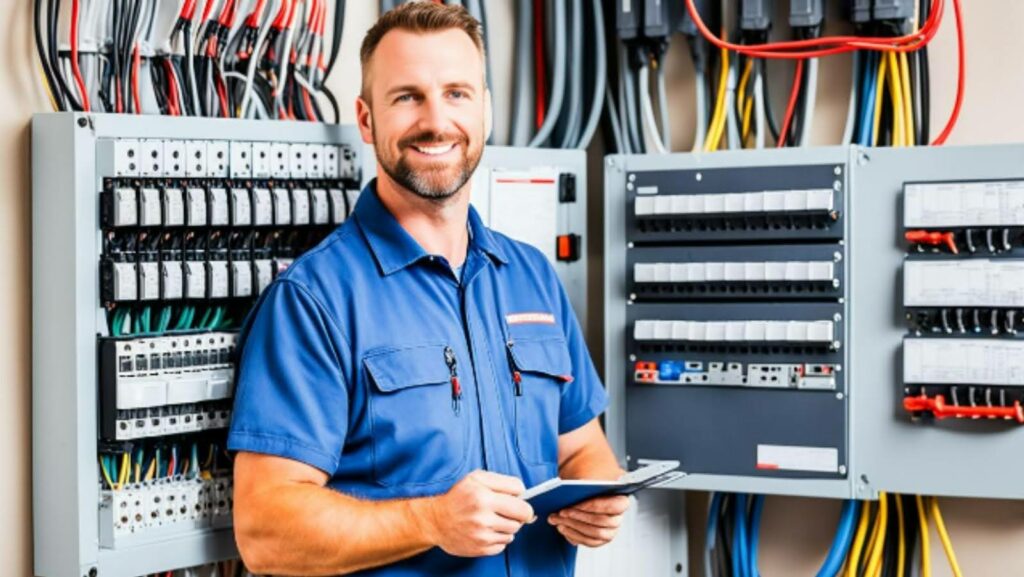
A panel ready for future upgrades saves you from having to change it often, avoiding big costs later.
Maintaining Your New Electrical Panel
Now that your new electrical panel is in, it’s vital to look after it well. This ensures it works safely for a long time. Make sure to get it checked and keep up with maintaining it.
Regular Inspections and Preventive Maintenance
Have a licensed electrician check your new electrical panel now and then. They will look closely for any wear, damage, or issues. This early attention prevents bigger problems, keeping your system safe for the long haul.
You should also do some simple preventive maintenance yourself. Regularly check the outside of your panel for damage. Look for things like loose parts, rust, or parts that are getting too hot. And, always keep the area around your panel clear. This means no clutter or things that can catch fire. Clear space helps with cooling and lets you reach the panel easily if needed.
Keeping your new electrical panel in good shape is a smart move. Regular checks and simple maintenance will make it last longer. It also keeps your home and loved ones safe from electrical problems.
Electrical Panel Replacement: A Worthwhile Investment
Swapping an old or faulty electrical panel is a major but worthy home upgrade. It offers lots of perks for homeowners. Prioritizing why electrical panel replacement is worthwhile investment lets homeowners benefit from more safety, peace of mind, better energy use, and save money in the long run.
Increased Safety and Peace of Mind
Thinking about replacing an electrical panel for safety is crucial. Older panels might lack key safety parts like AFCIs and GFCIs.
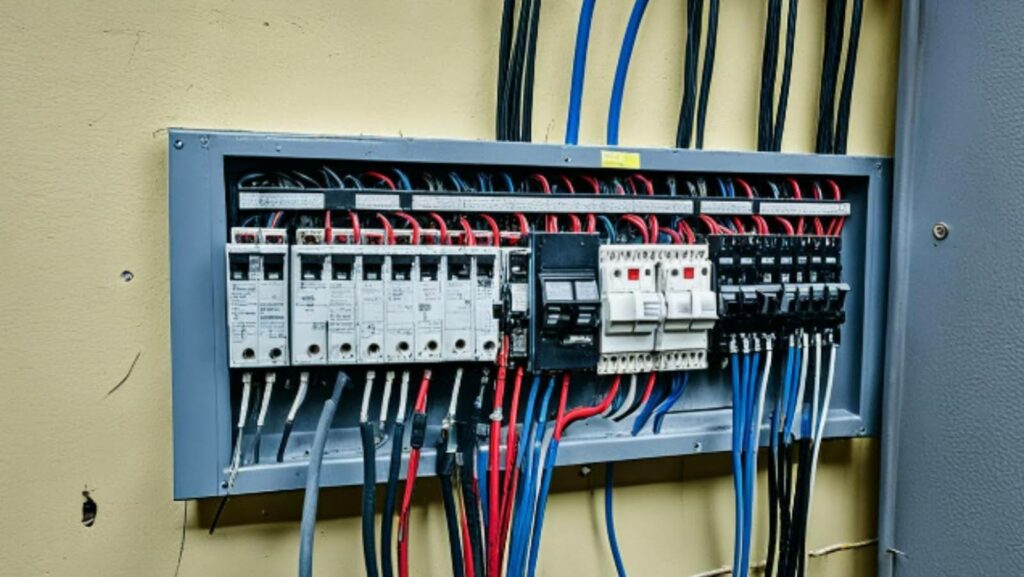
These prevent electrical fires and shocks. With a new, code-compliant panel, homeowners can feel safer and worry less about their family’s electrical safety.
Improved Energy Efficiency and Cost Savings
Switching out an old electrical panel isn’t just about safety. It can boost energy use and save money over time. Old panels struggle with today’s home power needs, wasting energy and raising bills. A new panel that meets your home’s energy needs now and later means spending less over time on energy.
Conclusion
Putting in a new electrical panel is a big deal for your home. It makes your house safer, more efficient, and raises its value. The cost can be between $1,500 to $3,000, but the average is about $2,000.
If you see your electrical panel acting up, like often tripping breakers, it’s a sign to act. This helps keep your home’s electrical work safe and reliable. The price varies based on the new panel’s size, what it can handle, and how hard it is to put in.
Getting a new electrical panel is worth it. It boosts safety, gives peace of mind, and saves money on energy in the long run. With the right electrician, getting it done is smooth. They handle permits and make sure your house is ready for today’s electrical needs.
FAQ
What are the Signs that My Electrical Panel Needs to be Replaced?
Frequent breaker trips, lights that flicker or dim, and not enough circuit breakers are signs. Also, old panels may lack safety features like AFCIs and GFCIs.
What Factors Influence the Cost to Replace an Electrical Panel?
The size and capacity of the new panel matter. So does the installation’s complexity. Where your home is and the electrician’s skills also affect the cost.
Do I Need a Permit to Replace my Electrical Panel?
Yes, in most places, you need a permit for electrical work involving the main panel. Not getting a permit can lead to fines and work redo.
Why is it Important to Hire a Licensed and Experienced Electrician for the Panel Replacement?
Working on an electrical panel without the right know-how is not just risky. It can also be illegal. A skilled electrician makes sure the job meets local codes safely.
What is the Average Cost to Replace an Electrical Panel?
The average cost to replace a panel is about $2,000 nationwide. However, the final cost will change based on the panel’s size, installation complexity, and home location.
How do I Choose the Right Electrical Panel for My Home?
Consider your energy needs now and in the future. Look at the panel’s capacity and how easy it is to upgrade. Talk with a licensed electrician for advice on the best panel for your home.
What are the Benefits of Replacing an Outdated Electrical Panel?
There are several gains from updating a panel. You’ll see better safety, energy use, and save money. Plus, it can up your home’s value.

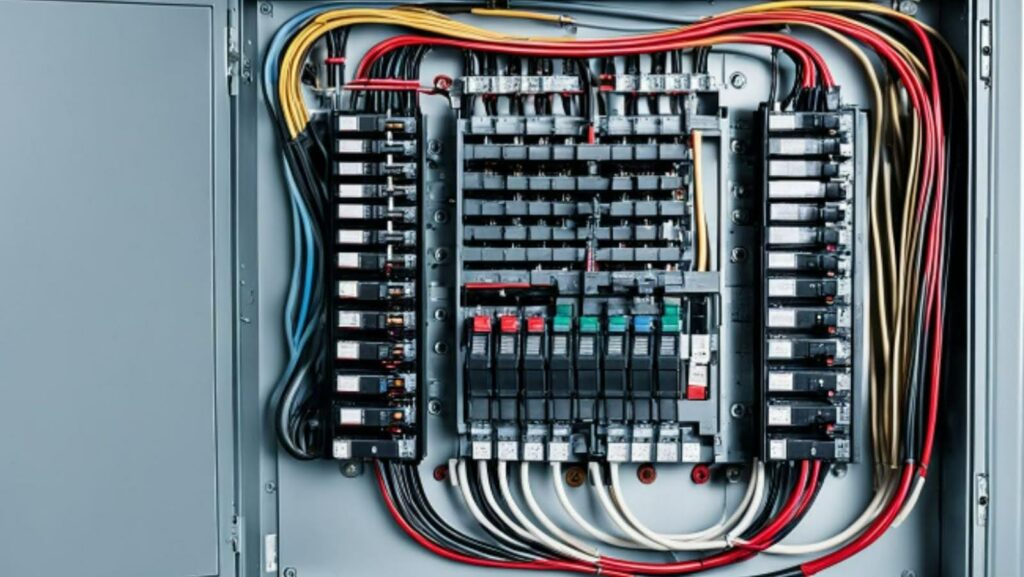
More Stories
PA Home:China’s Whole House Custom Manufacturer
Types of Materials Used for Industrial Buildings
5 Reasons to Call Sugar Wharf Condos at 138 Downes St Your New Home